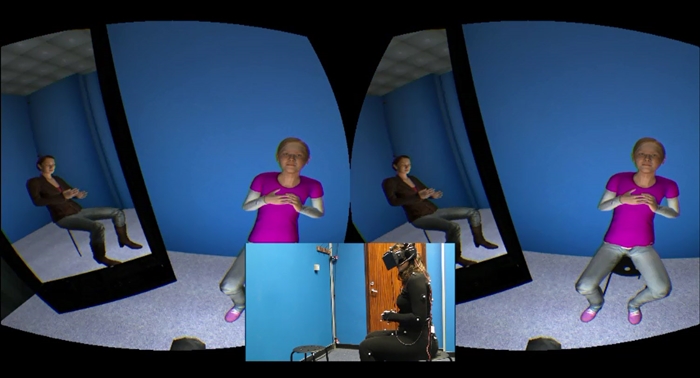
Scene from virtual reality scenario. Inset: participant in virtual reality exercise. (University College London)
15 February 2016. Individuals suffering from depression often express a high degree of self-criticism to the point it interferes with recovery from their disorder. Researchers from University College London showed in a pilot study that a virtual reality exercise could increase feelings of self-compassion and reduce the severity of depression, in some cases with enough improvement to be clinically significant.
The team from University College London or UCL, led by clinical psychologist Chris Brewin and computer scientist Mel Slater of UCL and University of Barcelona, reported their findings in the February 2016 issue of British Journal of Psychiatry Open. The study recruited 15 individuals, age 23 to 61, with previous episodes of depression, including 10 taking medication.
Depression is a widespread condition, which when it becomes persistent or severe, is called major depression, and can interfere with normal family and work life, and lead to disability. National Institute of Mental Health estimates in 2014, 15.7 million adults in the U.S., or 6.7 percent of the adult population, suffered a major depressive episode in the previous 12 months. World Health Organization says major depression carries the heaviest burden of disability among mental or behavioral disorders.
The researchers point out severe self-criticism is one of the key indicators of depression, which creates vulnerability and often interferes with recovery among people with the condition. Tools are needed, say the authors, to reduce these high levels of self-criticism in people with depression, and those tools need to be easy to deploy. Brewin, Slater, and colleagues — funded by a grant from the Medical Research Council in the U.K. — are evaluating virtual reality as a way of generating visually powerful exercises that engage people with depression and help develop more self-compassion to support their recovery.
Virtual reality creates computer-generated but life-like environments seen through special headsets, where individuals can navigate in multiple directions and interact with other characters through avatars representing themselves and others. People in virtual reality see themselves expressed in the scenes, moving in the same way as themselves, which makes it possible for participants to identify with their avatars and experience emotional reactions as those individuals.
The team prepared a scenario lasting about eight minutes, where as adult avatars they were trained to express compassion to a child in distress. By talking to and expressing compassion in the exercise, they were able to help the child respond positively and stop crying. The exercise then switched roles, where the individuals became the child avatars, receiving compassion and comfort from the virtual adults. The researchers first tested the approach and scenario for safety among healthy volunteers, which the team reported in November 2014.
In the new study, participants engaged in the exercise once a week for 3 weeks, with a follow-up 1 month later, where they completed self-reported standard scales of depression severity — the main outcome measure — as well as self-compassion and fear of compassion. The authors report 9 of the 15 participants expressed fewer depressive symptoms after the 1-month follow-up period.
In addition, 4 of the participants showed enough change to be considered clinically significant, with consistent improvement across multiple symptoms. “A month after the study,” says Brewin in a university statement, “several patients described how their experience had changed their response to real-life situations in which they would previously have been self-critical.”
The authors caution that the study is only a pilot test, with a small number of participants and no control group to test for placebo effects. “We now hope to develop the technique further to conduct a larger controlled trial” adds Slater, “so that we can confidently determine any clinical benefit. If a substantial benefit is seen, then this therapy could have huge potential.”
Read more:
- Electronic Patch Shown to Help Relieve PTSD, Depression
- Trial Testing MRI Depression Treatment with Teens
- Novartis Licensing Depression Therapy Technology
- University Faculty Design Mood-Tracking Mobile App
- Trial Shows Drug Reduces Depression in One Day
* * *

 RSS - Posts
RSS - Posts
You must be logged in to post a comment.